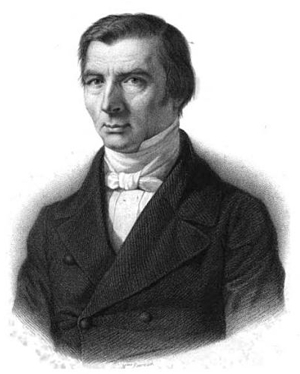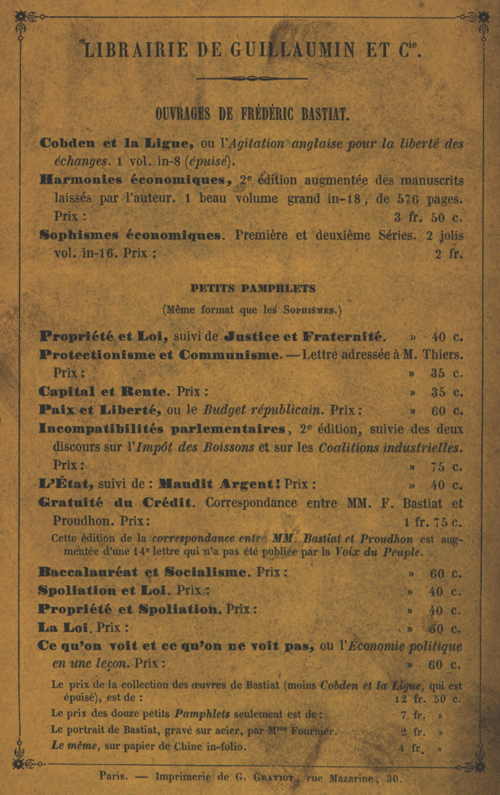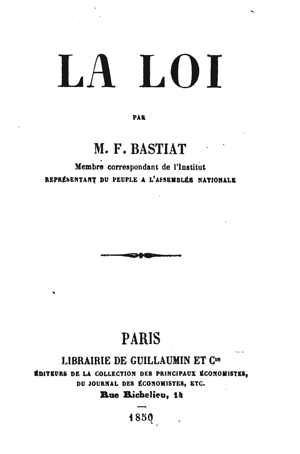The Trials and Tribulations of an Editor and Translator
[Note: See this page for a list of my writings on the Paris School of Political Economy.]
Inevitably there are a number of editorial and translation issues which arise when one attempts to translate, in the case of Frédéric Bastiat (1801-1850), 1 million words of a sometimes highly specialized nature (economic theory) written over 170 years ago. The plan was to publish Bastiat’s Collected Works in six large volumes with the appropriate scholarly apparatus of introductions, footnotes, glossaries, essays, data tables, and appendices.
This task was complicated by the fact that the original editor and translator died along the way, creating a problem like “the curse of the mummy” for those who were left behind.
As I worked on the project I had in mind some models of what I thought were outstanding examples of editorial work of important and complex scholarly texts. These included the following (in chronological order of publication):
- The Glasgow Edition of the Works of Adam Smith in 6 or 7 volumes. (Oxford University Press 1976; Liberty Fund 1981-1987). Edited and with Introductions by D.D. Raphael and A.L. Macfie, R H. Campbell, A.S. Skinner, W.P.D. Wightman, J.C. Bryce, R.L. Meek, P. G. Stein, E. C. Mossner and I. S. Ross.
- John Robson’s edition of the Collected Works of J.S. Mill in 33 volumes: Collected Works of John Stuart Mill, ed. J.M. Robson (Toronto: University of Toronto Press, London: Routledge and Kegan Paul, 1963-1991), 33 vols. Edited and with Introductions by Lord Robbins, V.W. Bladen, Joseph Hamburger, R.F. McRae, Alan Ryan, F.E.L. Priestley, F.E. Sparshott, F.A. Hayek, Francis E. Mineka, Dwight N. Lindley, Alexander Brady, John C. Cairns, Stefan Collini, Ann P. Robson, John M. Robson, Bruce L. Kinzer, Martin Moir, and Marion Filipiuk.
- the Complete Works of J.B. Say under André Tiran’s direction which began in 2003: Jean-Baptiste Say, Œuvres Complètes. André Tiran et al. (Paris: Economica, 2003-). 10 volumes.
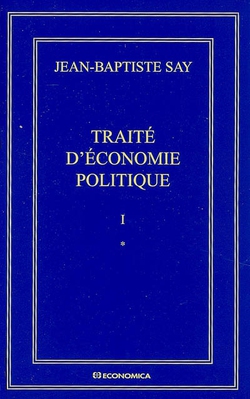
Editorial Issues and Problems
Identifying and Planning the Arrangement of the Content
An important first stage in the project, which was not achieved or even attempted, should have been to make a complete list of all Bastiat’s known works in chronological order and to give them a unique ID number, to provide full bibliographic information including the place and date of first publication, and its location (where applicable) in the two Oeuvres complètes editions of his work edited by his friends Paillottet and Fontenay in the 1850s and 1860s. This I did somewhat later when I came to realize how important this was (although I could not convince my colleagues of the importance of doing this).
Then a search should have been made for other works by Bastiat which were not included in the original Oeuvres Complètes (1854-55 and 1862-64) which formed the basis of the new translation. I did this once the project was underway and found additional letters and speeches in the Chamber of Deputies, along with different versions of journal and encyclopedia articles which Bastiat had revised for republication in other places.
This same mistake has not been made with the massive and very ambitious Collected Works of Molinari which Benoît Malbranque is currently doing for the Institut Coppet.
My preference, as an historian, is for the works to be organised in chronological order in order to show how his interests and opinions changed over time. The original editor of the Liberty Fund edition of Bastiat’s Collected Works wanted to arrange the material by “theme” which was a very poor choice in my view as much of what Bastiat wrote cut across disciplines, which one might have expected given the fact that he was a “political economist” who also was a pioneer in liberal sociological analysis of the state and its ruling class. So for Bastiat where does “politics” end and “economics” begin, I wonder? There were also very clear breaks in Bastiat’s career which caused him to focus on very different matters at different times in his life, for example his writings done his home town and province before he moved to Paris, his early years working purely on free trade matters, then his career as an elected politician during and after the 1848 Revolution, his shift to opposing the rise of socialism, and all the while he was also working on a theoretical economic treatise which he never lived long enough to complete.
Putting the Content into its Theoretical and Historical Context
Some of the noteworthy aspects of the editions of Smith, Mill, and Say mentioned above which I wanted to replicate in the Bastiat edition were the following:
- the lengthy and informative introductions written by experts;
- the extensive footnotes which identified changes made to the text in different versions, for example a chapter in his treatise might have started out as an article in the Journal des économistes, reprinted as a pamphlet, and then used again in his book with slight changes made for each format
- the source of the ideas the author was arguing for or against, especially in the form of quotations of other texts
- the identity and intellectual viewpoint of the many individuals mentioned by the author (whether politicians of the day, historical figures, other theorists, or personal friends),
- the historical events and institutions referred to (often in passing) which might be unfamiliar to modern day readers,
- and in the case of Bastiat the economic journalist, the source of the economic data he referred to and the accuracy of the economic data he used to make his points
- for key concepts and terms, some of which were invented by Bastiat and hence unique to him, one needed to identify when they were first used, how they may have changed over time, and the connections which existed between it and other related terms and expressions (what I called “vocabulary clusters”)
- with the hundred or so letters by Bastiat which we have, to identify the people, organisations, and “networks” in which he moved, and the nature of his personal relationships
- given his literary bent, his sense of humor and wicked wit, and his penchant for satire and puns, to identify the source of his quotations from, say Molière, to note any changes he made to Molière’s quote which he would sometimes make to serve his own political purposes (such as changing the names of historical political figures to more contemporary ones), or creating his own poems which parodied a classic version.
Here I will give two more detailed examples of what I thought needed to be done as an editor and translator:
- checking Bastiat’s accuracy as an economic journalist and his many critiques of government spending and taxation, especially concerning tariffs and the military budget; which led to me reconstruct the French government budget for 1848-49 (in CW vol. 3) based upon official French government documents
- identifying and mapping out the connections between some of the key terms and concepts Bastiat used in his economic and social theory; which led to me creating a visual way to illustrate the cluster of terms he used in what is commonly called a “concept or mind map”
Assessing Bastiat’s Accuracy as an Economic Journalist
Here is one page from Appendix 4 “French Government’s Budgets for Fiscal Years 1848 and 1849” in CW3 (pp. 509-16) OLL online version which contains my reconstruction of the French government’s budget for the years 1848 and 1849, which was the time he served in the Chamber of Deputies and was appointed Vice-President of the Finance Committee which advised the Chamber on economic matters.
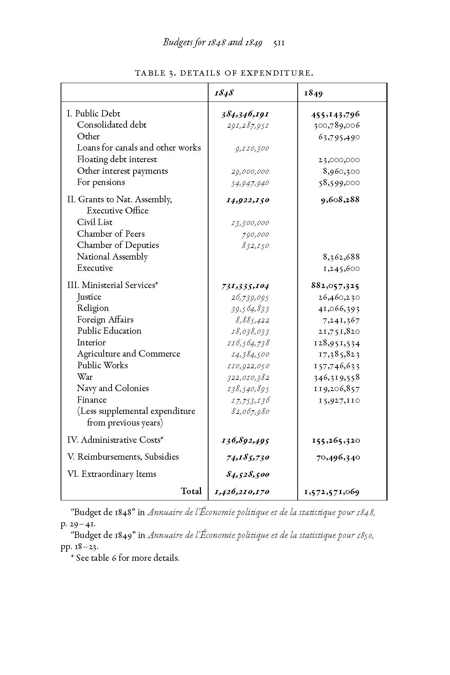
What surprised me was how accurate Bastiat was in his writing about economic matters. I could only find one example of Bastiat asserting that the government had spent a certain amount on something (in this case subsidizing the colony in Algeria) which I could not independently verify.
Translation Issues and Problems
Introduction
A difficulty with a large project like the translation of the Collected Works of Bastiat which is large in size (over 1 million words organised into six large volumes) as well as being conducted over more than a decade, is to ensure consistency. Another problem is the fact that an economist like Bastiat used a very specific technical vocabulary which only a translator trained in economics or the history of economic thought would appreciate. Other translators who might be proficient as business or commercial translators might not appreciate the specific historical context in which Bastiat was writing and the vocabulary which was current at the time. Other translators who specialized in political thought might not appreciate the uniqueness and specialized nature of economic terminology and the necessity to translate the same term the same way each time. Too often, the need to avoid “repetition” for stylistic reasons would result in the use of a “synonym” and therefore interfere with the technical precision the author was trying to maintain.
Hence the need to draw up a “vocabulary list” of key terms and expressions in order to be able to translate the same word or term the same way each time they occurred in the text. This was not done at the very beginning and so left the door open to serious problems later in the project. The lack of consistency in word choice became a problem for the Liberty Fund project as to date there have been four translators used over a period of two decades, with different practices adopted at various times.
An example of the “vocabulary list”:
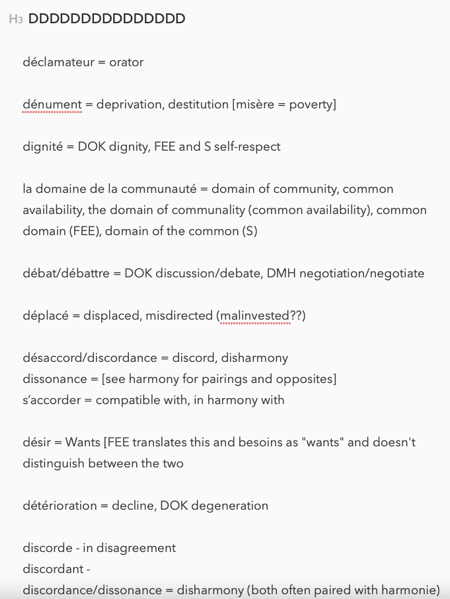
I might also mention the problem English speakers face, given the close historical connection between the French and English languages (I refer here to the “Norman Conquest” of course), to resort to using English cognates of French words. This is an example of linguistic laziness which would sometimes result in significant misunderstandings.
When making a new translation of a work which has been translated before there is a need for the editor to flag any changes or new terms used and to explain why the change was made. In the case of some of Bastiat’s works, such as his treatise Economic Harmonies, readers would be familiar with the translation made by Stirling in the 1860s and 1870s and that by FEE in the 1960s, and so might resist any changes made in a new translation unless an adequate reason was provided. This was done in numerous footnotes in the new Liberty Fund translation.
Four good examples of changes in terminology which I thought were necessary were “la spoliation” (plunder), “la classe” (class), “la déplacement” (displacement or misallocation), and “par ricochet” (the ricochet effect). For each term Bastiat had a very specific meaning in mind, and each was crucial to his sophisticated and sometimes complex social and economic theory. In order to clarify these matters I wrote a number of small essays to explain the origin and significance of these key terms which I included in an Appendix.
- Stirling and other 19th century translators were quite happy to translate “la spoliation” with the antiquated English word “spoliation” or sometimes “exploitation”.
- Bastiat’s theory of class and his class analysis of society was not appreciated by any of the previous translators of his work and the nuances of his theory were largely ignored. On both “class” and “plunder” see “Bastiat’s Theory of Class: The Plunderers vs. the Plundered” (CW3, pp. 473-85); and also “History of Plunder” (CW5).
- In order to understand how government intervention in the economy caused problems, Bastiat developed the idea of “la déplacement” (displacement or the Austrian notion of misallocation), especially of labour and capital. By this he meant the distortions or misallocation of resources into economically unviable areas which would sooner or later have to be allocated elsewhere or lost. Previous translators did not understand this and thus did not translate the term properly. See “Theory of Displacement” (CW5); also see the related terms “Disturbing and Restorative Factors” (CW4).
- The term “ricochet” was also largely ignored by earlier translators who would sometimes use the English word “indirect” (FEE) or nothing at all, to describe an important concept in Bastiat’t emory of how parts of an economy are interlinked with each other, often through price signals. See “The Sophism Bastiat never wrote: The Sophism of the Ricochet Effect” (CW3, pp. 457-61)
Concept Maps and Vocabulary Clusters
After spending some years on the project I noticed a ‘“clustering” of terms around certain key concepts like “class” and “plunder”. Having his entire body of work in French and in electric form made it easy to explore the interconnections between related concepts, the common pairing of terms (such as “natural” and “artificial”), his use of synonyms, and when he began using these terms.
In order to “map” his use of these terms I created a number of diagrams to illustrate these “vocabulary clusters”. I identified about a dozen of these “clusters” and have created “maps” for six of them so far (in bold). These maps can be found in the Appendix below, and also here:
- theory of plunder
- theory of class
- human action
- harmony vs. disharmony
- disturbing vs restorative factors
- the seen and the unseen
- the ricochet effect and the transmission if information through prices: metaphor of water, hydraulics, electricity
- social mechanism and the driving force of society
- apparatus of exchange
- service for service
- sophism, fraud, and dupes
To illustrate in detail what these word “clusters” involve, here is the image followed in text form the key terms and related words and expressions for the cluster on “La Spoliation” (Plunder):
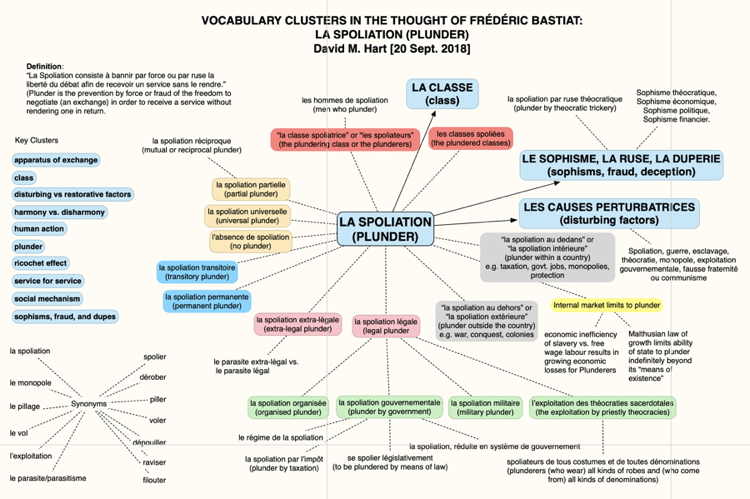
(See a larger version (3,000px) of the image here.)
Synonyms:
- la spoliation
- le monopole
- le pillage
- le vol
- l’exploitation
- le parasite/parasitisme
- spolier
- dérober
- voler
- dépouiller
- piller
- raviser
- filouter
Class [see related word cluster “La Classe”]:
- “la classe spoliatrice” or “les spoliateurs” (the plundering class or the plunderers)
- les hommes de spoliation (men who plunder)
- les classes spoliées (the plundered classes)
Degree:
- la spoliation partielle (partial plunder)
- la spoliation réciproque (mutual or reciprocal plunder)
- la spoliation universelle (universal plunder)
- l’absence de spoliation (no plunder)
Time:
- la spoliation transitoire (transitory plunder)
- la spoliation permanente (permanent plunder)
Law:
- la spoliation extra-légale (extra-legal plunder)
- la spoliation légale (legal plunder)
- le parasite extra-légal vs.le parasite légal
- la spoliation organisée (organised plunder)
- la spoliation gouvernementale (plunder by government)
- le régime de la spoliation
- la spoliation par l’impôt (plunder by taxation)
- se spolier législativement (to be plundered by means of law)
- la spoliation, réduite en système de gouvernement
- la spoliation militaire (military plunder)
- l’exploitation des théocraties sacerdotales (the exploitation by priestly theocracies)
- spoliateurs de tous costumes et de toutes dénominations (plunderers (who wear) all kinds of robes and (who come from) all kinds of denominations)
Location:
- “la spoliation au dedans” or “la spoliation intérieure”(plunder within a country) e.g. taxation, govt. jobs, monopolies, protection
- “la spoliation au dehors” or “la spoliation extérieure”(plunder outside the country) e.g. war, conquest, colonies
Limits:
- Internal market limits to plunder
- economic inefficiency of slavery vs. free wage labour results in growing economic losses for Plunderers
- Malthusian law of growth limits ability of state to plunder indefinitely beyond its “means of existence”
The Challenges for the Translator created by the “Rhetoric of Liberty “ used by Bastiat
Over a period of three years (1845-1847) Bastiat developed his unique rhetorical style in the course of writing articles for a more popular audience in which he used humor and satire to make economics less “dry and boring”, a very provocative vocabulary of “theft” and other acts of violence in order to expose the follies and crimes of the policies of the ruling elite and their system of “legal plunder”, and to undermine their authority and legitimacy with “the sting of ridicule”. He also cleverly and wittily adopted the practice of telling stories to explain economic concepts. He would quote from the plays of Molière and the fables of La Fontaine which nearly every French school kid would have known, make up his own stories in a similar vein (such as his stories about the French “everyman” Jacques Bonhomme), or more complex and sophisticated thought experiments involving Robinson Crusoe and Friday on their “island of despair.” These more popular writings were published as two volumes of Economic Sophisms which appeared in 1846 and 1848.
The pinnacle of his use of stories to illustrate economic matters occurred in his magnum opus Economic Harmonies (1850,1851) in which I identified 55 “economic stories” (34 in EH1 (1850) and 18 in EH2 (1851), and 3 in the Taranne Hall lecture).
A list of the rhetorical devices used by Bastiat in the Economic Sophisms and the Economic Harmonies shows the breadth and complexity of what one might call his “rhetoric of liberty.” These literary and rhetorical devices pose a special problem for the translator in capturing the spirit and humor of the original language, tracking down the original literary reference or quote which Bastiat often changed to suit his own time and circumstances, and his penchant for punning. The latter placed the translator in the difficult position of having to explain his joke in a footnote, which would tend to make it less funny for the reader. The devices Bastiat used includes the following:
- A standard prose format which one would normally encounter in
a newspaper.
- The single authorial voice in the form of a personal conversation
with the reader.
- A serious, constructed dialogue between stock figures who represented
different viewpoints (in this Bastiat was influenced by
Jane Marcet and Harriet Martineau; Gustave de Molinari continued
Bastiat’s format in some of his writings in the late 1840s and
1850s).
- Satirical “official” letters or petitions to government officials or
ministers, and other fabricated documents written by Bastiat (in
these Bastiat would usually use a reductio ad absurdum argument
to mock his opponents’ arguments).
- The use of Robinson Crusoe “thought experiments” to make serious
economic points or arguments in a more easily understandable
format.
- “Economic tales” modeled on the works of classic French authors,
such as La Fontaine’s fables and Andrieux’s short stories
- Parodies of well-known scenes from French literature, such as
Molière’s plays.
- Quoting scenes of plays where the playwright mocks the pretensions
of aspiring bourgeois who want to act like the nobles who
disdain commerce (e.g., Molière, Beaumarchais).
- Quoting poems with political content, such as Horace’s ode on
the transience of tyrants.
- Quoting satirical songs about the foolish or criminal behavior of
kings or emperors (such as Napoléon). Bastiat seems to be familiar
with the world of the “goguettiers” (political song writers, especially
Béranger) and their interesting sociological world of drinking and
singing clubs.
- The use of jokes and puns (such as the names he gave to characters
in his dialogues (“Mr. Blockhead”), or place names [“Stulta” and
“Puera”), and puns on words such as “Highville” and “gaucherie”).
A good example of Bastiat’s parodying famous works of French literature (in fact Bastiat makes a parody of Molière’s parody) is his creation of an oath which recently appointed customs officials would have to make, modeled on the oath newly qualified doctors had to make in Molière’s play “The Hypochondriac”.
Here is Molière’s original version (in “dog Latin”) along with FEE’s excellent translation, which is followed by Bastiat’s amusing parody (which is actually a parody of Molière’s parody):
Ego, cum isto boneto
Venerabili et doctor,
Don tibi et concedo
Virtutem et puissanciam
Medicandi,
Purgandi,
Seignandi,
Perçandi,
Taillandi,
Coupandi,
Et occidendi
Impune per total terram. |
…
I give and grant you
Power and authority to Practice medicine,
Purge,
Bleed,
Stab,
Hack,
Slash,
and Kill
With impunity
Throughout the whole world |
And Bastiat’s parody of Molière from “Theft by Subsidy” (ES2 9):
Dono tibi et concendo
Virtutem et puissantiam
Volandi,
Pillandi,
Derobandi,
Filoutandi,
Et escroquandi,
Impunè per totam istam Viam. |
I give to you and I grant
virtue and power
to steal
to plunder
to filch
to swindle
and to defraud
At will, along this whole road |
Some Other Technical Issues
Introduction
The Bastiat translation project began in 2001 as a result of a conference held in Mugron (the village where Bastiat lived in the south of France) to celebrate the 200th anniversary of his birth. Unfortunately the first editor was not well acquainted with the internet and the digitization of texts and so the project was not fully digital from the very beginning, as it should have been, although one of its end products was to have been an online version.
Digital technology made it possible to do some very interesting things with the underlying text, but it also posed certain challenges for the editors and translators, which I will discuss below.
Using Gallica and Google Books to find copies of the texts
I have made considerable use of the ambitious digitization programs of two bodies, the digital collection “Gallica” of the Bibliothèque nationale de France (began in October 1997) and Google Books (began December 2004). I was able to use them to find copies of the first editions of Bastiat’s works, as well as later editions which sometimes were different from the first editions. The early versions of the texts were often poorly scanned with blurry or missing pages, and sometimes the operators of the scanning machines accidentally scanned their hands and fingers in the process. Over the years I have made a sizable collection of images of what I call “Google fingers”.

The different strengths and weaknesses of Gallica vs. Google Books meant that I had to use both for different purposes: the Google Books search function (especially across multiple texts) was better than Gallica’s, but the bibliographical information available for each text was far better at Gallica than for Google Books (which is in fact appalling).
The better search function of Google Books meant that it was possible to search for a string of text, say a line from a play by Molière, and find an edition of the text Bastiat may well have used, which is the one I would then cite in a footnote.
Creating a searchable electronic version of the Texts
The next step after finding suitable PDF versions of the texts was to create a searchable text version (an Apple Pages file). In the early days OCR technology was fairly primitive and created lots of errors. Eventually I was able to create one single and very large file of the seven volume 1864 edition of Bastiat’s Oeuvres complètes and several other texts which were not included in that edition (another volume of letters, some speeches in the Chamber, and some other shorter pieces). I then organised the texts into chronological order. This file contained just over 1 million words (in French) and was 8.1 MB in size.
The creation of this file made it possible to do word searches over the entire body of his work to identify things like the “cluster” of terms he used for each of his main key concepts (such as “plunder” and “class” and “human action”), as well as his first use of terms which was required to track the evolution of his thinking over time. For example, it became apparent that a seminal article in the development of his thinking as well as his word use was an article on the “right to a job” which appeared in Journal des Économistes, Feb. 1845. Below is the standard identification (“T” = “text”) and bibliographic format I used for all items in the collection:
T.23 (1845.02.15) “Letter from an Economist to M. de Lamartine. On the occasion of his article entitled: The Right to a Job” (Un économiste à M. de Lamartine. A l’occasion de son écrit intitulé: Du Droit au travail), Journal des Économistes, Feb. 1845, T. 10, no. 39, pp. 209-223 [OC1.9, pp. 406-28] and [CW4].
Once I had identified a number of key terms, such as “ricochet” and “la déplacement”, which had been mistranslated or translated inconsistently, I was able to find all such occurrences of the term and then make sure the new translation was consistent.
Coding the Texts
We spent a considerable amount of time working with a firm to develop a suitable DTD (Document Type Definition) for the conversion of the texts to an archival XML and then to HTML. To be brief, one of the key features was to make the “paragraph” the key element in the text, where each one would have a unique ID number so that word searches and citations of the text would point to the particular paragraph in which the key word or phrase was located.
Citing the Texts
My philosophy in building an online library of digital texts is to have the texts available in a variety of formats (facsimile PDF, HTML, and various eBook formats). The facsimile PDF is very important because I believe we must always go back to the original, or at least have it readily available, in order, if you will, “keep us honest” and to be able to show the reader that we have not altered the text in any significant ways (other than say simple formatting).
Within the HTML version it is important to include the original page numbers so that the reader can cite the relevant page in a footnote or scholarly article. Since each paragraph in the HTML version of the text has a unique ID number the reader can also make a direct URL link to it, also for the purposes of citation.
For example, to cite a passage in one of my French language editions of Bastiat’s work, his classic Ce qu’on voit et ce qu’on ne voit pas (What is Seen and what is not Seen) (1850) I could use the page number [in bold] or the direct URL (to “para-14”) here:
[3]
Dans la sphère économique, un acte, une habitude, une institution, une loi, n’engendrent pas seulement un effet, mais une série d’effets. De ces effets, le premier seul est immédiat; il se manifeste simultanément avec sa cause, on le voit. Les autres ne se déroulent que successivement, on ne les voit pas, heureux si on les prévoit!
Entre un mauvais et un bon Économiste, voici toute la différence: l’un s’en lient à l’effet visible; l’autre tient compte et de l’effet qu’on voit et de ceux qu’il faut prévoir.
Mais cette différence est énorme, car il arrive presque toujours que, lorsque la conséquence immédiate est favorable, les conséquences ultérieures sont funestes, et vice versâ. — D’où il suit que le mauvais Économiste poursuit un petit bien actuel qui sera suivi d’un grand mal à venir, tandis que le [4] vrai Économiste poursuit un grand bien à venir, au risque d’un petit mal actuel.
I have also adopted in my own scholarly writing the practice of citing in parallel the French original and the English translation. Here is the same passage alongside the Liberty Fund edition of CW3 (which unfortunately does not include the original page numbers of the text) and At the OLL:
| Dans la sphère économique, un acte, une habitude, une institution, une loi, n’engendrent pas seulement un effet, mais une série d’effets. De ces effets, le premier seul est immédiat; il se manifeste simultanément avec sa cause, on le voit. Les autres ne se déroulent que successivement, on ne les voit pas, heureux si on les prévoit! |
In the sphere of economics an action, a habit, an institution, or a law engenders not just one effect but a series of effects. Of these effects only the first is immediate; it is revealed simultaneously with its cause; it is seen. The others merely occur successively; they are not seen; we are lucky if we foresee them. |
| Entre un mauvais et un bon Économiste, voici toute la différence: l’un s’en lient à l’effet visible; l’autre tient compte et de l’effet qu’on voit et de ceux qu’il faut prévoir. |
The entire difference between a bad and a good Economist is apparent here. A bad one relies on the visible effect, while the good one takes account both of the effect one can see and of those one must foresee. |
| Mais cette différence est énorme, car il arrive presque toujours que, lorsque la conséquence immédiate est favorable, les conséquences ultérieures sont funestes, et vice versâ. — D’où il suit que le mauvais Économiste poursuit un petit bien actuel qui sera suivi d’un grand mal à venir, tandis que le [4] vrai Économiste poursuit un grand bien à venir, au risque d’un petit mal actuel. |
However, the difference between these is huge, for it almost always happens that when the immediate consequence is favorable, the later consequences are disastrous and vice versa. From which it follows that a bad Economist will pursue a small current benefit that is followed by a large disadvantage in the future, while a true Economist will pursue a large benefit in the future at the risk of suffering a small disadvantage immediately. |
Here is an example of my use of a parallel quote in an essay which also contains footnotes:
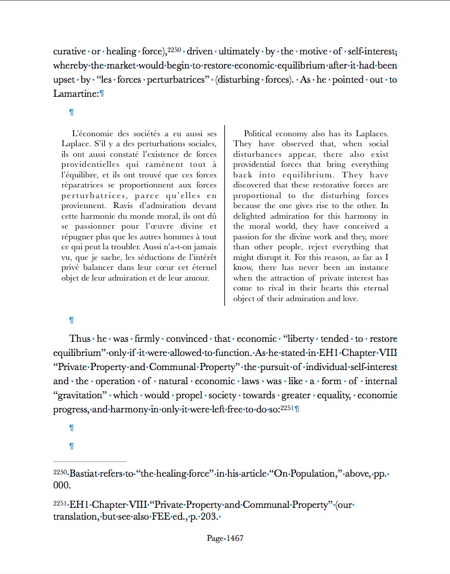
Displaying the electronic version of the texts
I believe that it would be very useful to be able to show the entire text, not just selected paragraphs, in this parallel, side-by-side manner. I have experimented using the HTML element “iFrame” in order to do this. [See the entry HTML element – Wikipedia.] This enables the viewing of the original French text (either a facsimile PDF out HTML) against the English translation, and to compare English translations side-by-side (say Stirling’s vs. FEE’s).
The iFrame feature also allows a more ambitious and richer way to view a heavily annotated text, such as the ones I have created, which allows the “footnotes” to be viewed in one frame (I prefer the left), and the large middle frame with the main body of the text, and on the right any glossaries or appendices. This minimises the need for scrolling online or turning pages with a physical book. Thus one can jump from the main text to an endnote or glossary and back again in order to keep reading. This manner of viewing texts was the original idea behind “hypertext” but it has never really caught on, perhaps because of the need for a large screen in order to show the text properly. However, this problem has largely disappeared with the dramatic fall in prices of wide screen monitors, but the preference of many people to read texts on “mobile devices” is a further impediment to viewing complex hypertexts.
Here is a screen snapshot of an iFrame page showing in four frames the table of contents (top frame), an older English translation (left frame), the French original (centre frame), and another English translation (right frame).I used this a great deal to compare the word choices made by different translators of the same French word.
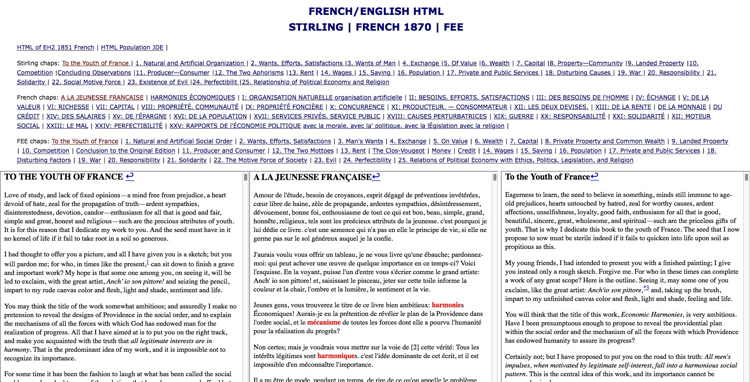
Here is another screen snapshot showing in four frames a way of reading a complex, heavily annoyed text, with the table of contents (top frame), the footnotes or endnotes (left frame), the English translation (centre frame), and glossaries and other supplementary material (right frame):
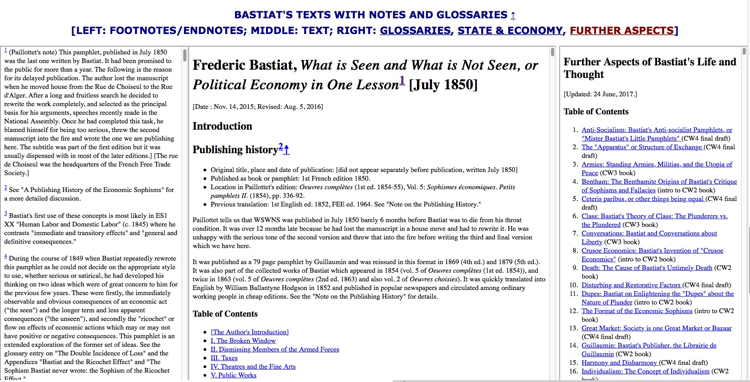
Some Final Thoughts
My engagement with the “Paris School” of political economy began in 1978-79 when I first met Leonard Liggio who introduced me to it, which resulted in me writing my first scholarly piece on the ideas of Gustave de Molinari (1979), and then the work of Charles Comte and Charles Dunoyer (1983-86). Bastiat came much later.
In a rash moment I decided in 2016 to write a screenplay for a film on the life and work of Bastiat, especially his involvement in the Revolution of February 1848. I was interested in how ideas might be depicted in a film, on which I have written a couple of pieces. A model I had in mind was Warren Beatty’s great film “Reds” (1980) about the American journalist John Reed in Bolshevik Revolution. The result was “Broken Windows”.

Appendix 1: Word Maps and Vocabulary Clusters for Bastiat’s Key Terms and Concepts
See “Vocabulary Clusters in the Thought of Frédéric Bastiat” (July 2022) here for more details.
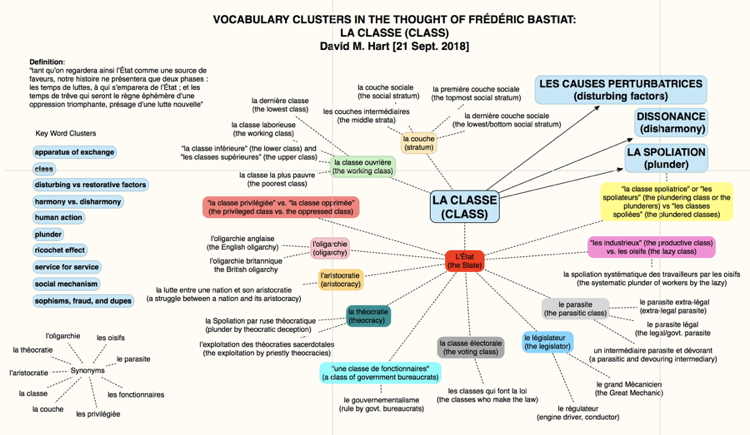
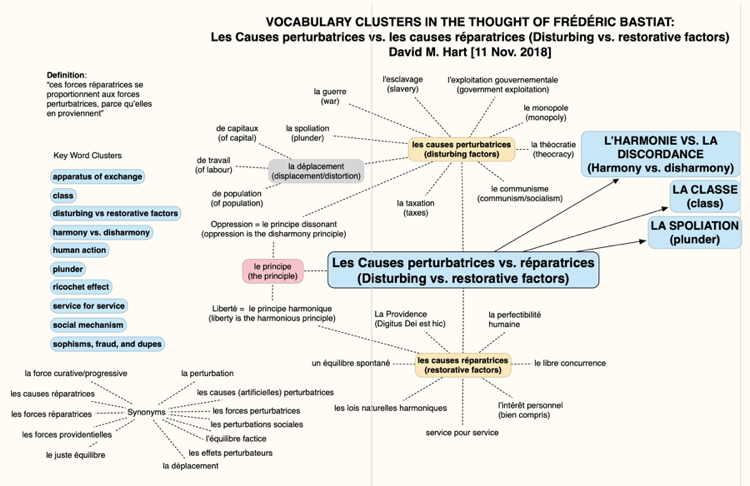
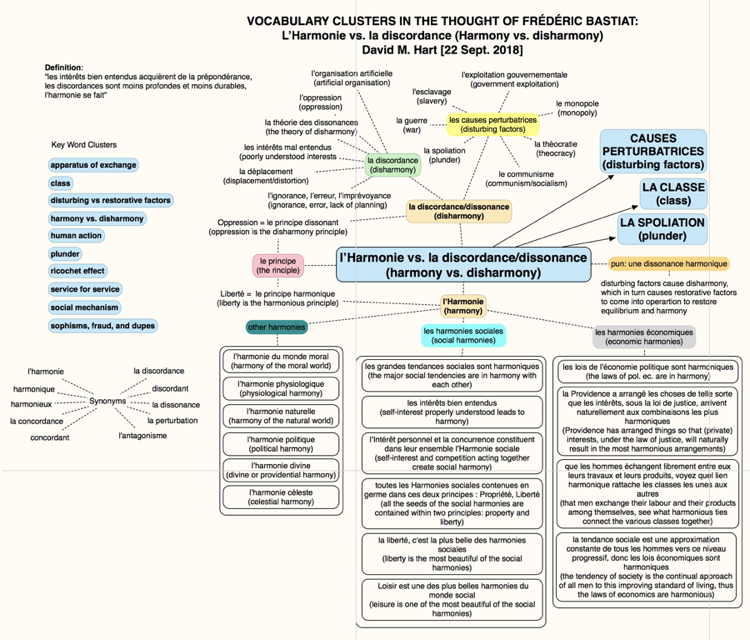
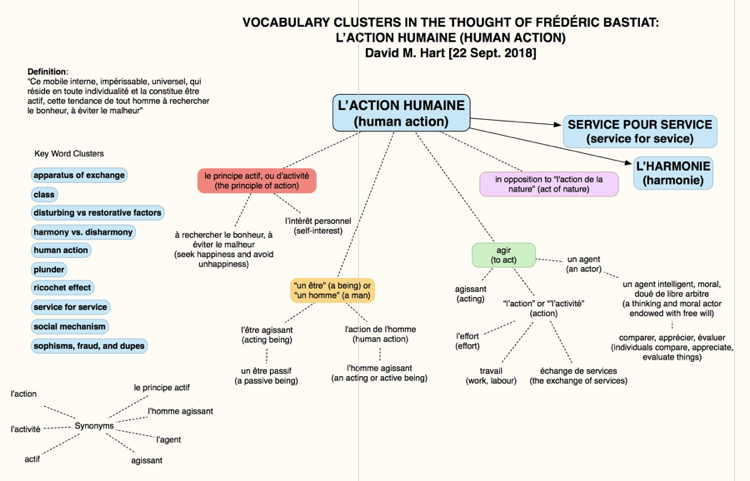

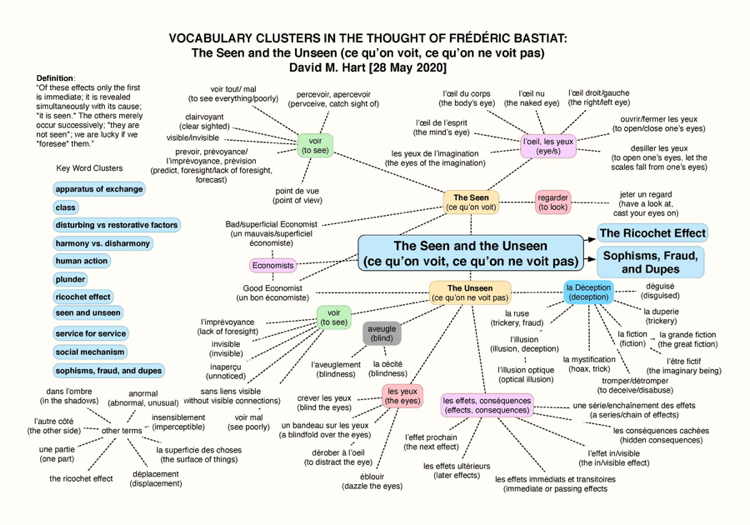
Endnotes















